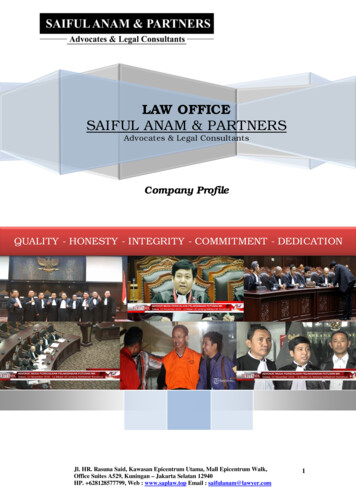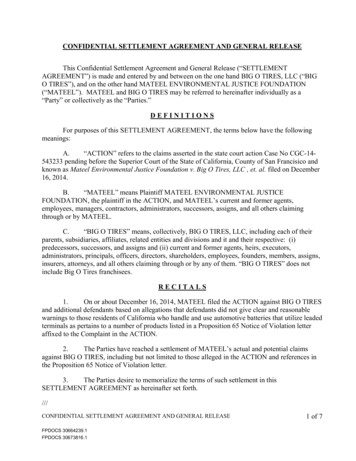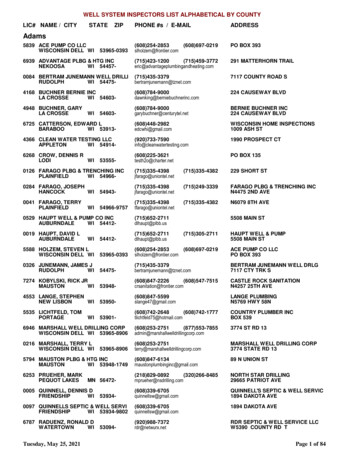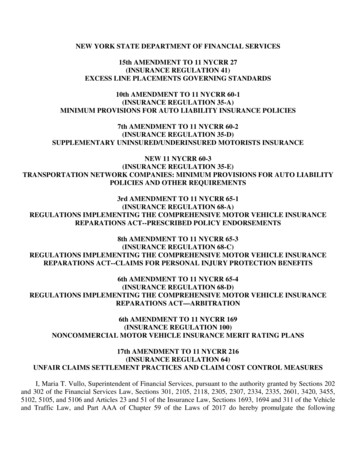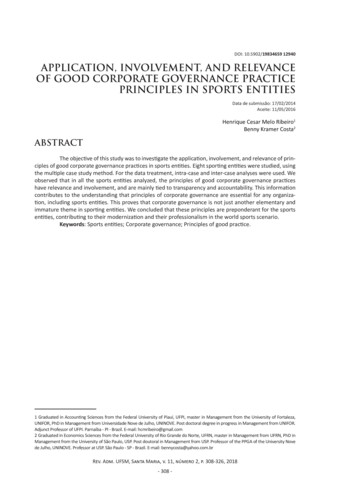
Transcription
DOI: 10.5902/19834659 12940APPLICATION, INVOLVEMENT, AND RELEVANCEOF GOOD CORPORATE GOVERNANCE PRACTICEPRINCIPLES IN SPORTS ENTITIESData de submissão: 17/02/2014Aceite: 11/05/2016Henrique Cesar Melo Ribeiro1Benny Kramer Costa2ABSTRACTThe objective of this study was to investigate the application, involvement, and relevance of principles of good corporate governance practices in sports entities. Eight sporting entities were studied, usingthe multiple case study method. For the data treatment, intra-case and inter-case analyses were used. Weobserved that in all the sports entities analyzed, the principles of good corporate governance practiceshave relevance and involvement, and are mainly tied to transparency and accountability. This informationcontributes to the understanding that principles of corporate governance are essential for any organization, including sports entities. This proves that corporate governance is not just another elementary andimmature theme in sporting entities. We concluded that these principles are preponderant for the sportsentities, contributing to their modernization and their professionalism in the world sports scenario.Keywords: Sports entities; Corporate governance; Principles of good practice.1 Graduated in Accounting Sciences from the Federal University of Piauí, UFPI, master in Management from the University of Fortaleza,UNIFOR, PhD in Management from Universidade Nove de Julho, UNINOVE. Post doctoral degree in progress in Management from UNIFOR.Adjunct Professor of UFPI. Parnaíba - PI - Brazil. E-mail: hcmribeiro@gmail.com2 Graduated in Economics Sciences from the Federal University of Rio Grande do Norte, UFRN, master in Management from UFRN, PhD inManagement from the University of São Paulo, USP. Post doutoral in Management from USP. Professor of the PPGA of the University Novede Julho, UNINOVE. Professor at USP. São Paulo - SP - Brazil. E-mail: bennycosta@yahoo.com.brRev. Adm. UFSM, Santa Maria, v. 11, número 2, p. 308-326, 2018- 308 -
Henrique Cesar Melo Ribeiro,Benny Kramer Costa1 INTRODUCTIONThe study of corporate governance has grown a lot, especially after a series of corporate scandals that have occurred in companies such as Enron and WorldCom (Neubaum & Zahra,2006), which have had large social impacts (Lopes & Tukamoto, 2007). Prior studies have foundthat both corporate social responsibility and good governance are needed to maintain companyperformance (Heath & Norman, 2004; Kolk & Pinkse, 2010). These results generated a movementfor greater transparency in organizations, aligned with various governance standards.Corporate governance is an expression that is becoming known in many areas of Brazilian society (Grün, 2005) as well as abroad (Newland, 2010). Corporate governance refers to a setof processes (Erfurth & Bezerra, 2013) that generate good practices (Carioca, De Luca, & Ponte,2010), based on the following guiding principles: transparency, accountability, equity, and ethics(Chen et al., 2007; Rodriguez-Dominguez, Gallego-Alvarez, & Garcia-Sanchez, 2009).Since the 1990s, good corporate governance practices have been implemented in publicly traded organizations (Souza & Borba, 2007). Since then, studies on corporate governancehave been perfected and disseminated through the academy (Ribeiro, 2013), not only in researchin the private sector (Miranda & Amaral, 2011), but also in the public sector (Marques, 2007), thethird sector (Marques & Costa, 2009), and in the sports sector (Ferkins, Mcdonald, & Shilbury,2010; Ferkins & Shilbury, 2012).Among these sectors, sport (Cruz et al., 2010) is configured not only as an important socializing agent (Rubio, 2006), but also as a business subjected to market principles, notably withregard to the professional level of competitiveness (Alves & Pieranti, 2017). In this line, the researchquestion that guided this study was: How does the application, involvement, and relevance of principles of good practices of corporate governance occur in sports entities? Thus, the general objective of this research was to investigate the application, involvement, and relevance of the principlesof good corporate governance practices in sports entities. Corporate governance is emphasizedhere in sports organizations, which, is an underexplored, emerging field (Ferkins, 2007).The importance of this theme came from the interest of better understanding howthese entities relate to the principles of good corporate governance practices (Foster, 2006). Inthis context, it is necessary to understand how the mechanisms of governance act in these entities (Meira, Bastos, & Böhme, 2012). As a result of the growth they are experiencing, theseentities are increasingly exposed to inevitable market forces, and in this process they strive tomaintain management, control, and decision-making, thus avoiding issues of agency conflicts(Ferkins, Shilbury, & Mcdonald, 2009).This work is justified, since the International Sports Organizations in the world serve asparameters for observing the implementation of the market logic in these sports entities. This,in turn, impacts the insertion and adoption of the elements of businesses in the managementof these organizations (Gonçalves & Carvalho, 2006). That is, these organizations need to adaptto the new organizational management mechanisms (Pires, 2009), such as the good practices ofCorporate Governance (Ferkins, Shilbury, & Mcdonald, 2009; Ferkins & Shilbury, 2012), to betterinform users, and such initiatives will be directly reflected in performance (Malacrida & Yamamoto, 2006). It is consistent that good governance practices, through their principles, are capableof shaping the management of sports organizations (Lakshman & Akhter, 2013), impacting theirdevelopment (Thoma & Chalip, 1996; Ferkins & Shilbury, 2015).The rationale and importance of working on this theme is reinforced by the need for abetter understanding of good corporate governance practices, through its principles, in sportsRev. Adm. UFSM, Santa Maria, v. 11, número 2, p. 308-326, 2018- 309 -
Application, involvement, and relevance of good corporate governance practiceprinciples in sports entitiesentities in Brazil. This focus on this theme will contribute to the academic literature to increasethe knowledge of corporate governance, insofar as it includes a new dimension to the problem- that of sports entities.This article is structured in five sections: the first highlights the introduction, question,purpose, justification, and contribution of the study. The second section looks at the theoreticalbasis, focusing on the principles of good practices and sports organizations. Soon after, the methodological procedures are presented. Then comes the analysis and discussion of the results. Andfinally, the final considerations section highlights the main results, contributions, limitations, andsuggestions for future studies.2 THEORETICAL FOUNDATIONSThis section presents the principles of good corporate governance practice, outlinessporting entities in the national context, and emphasizes corporate governance in sports entities.2.1 Principles of Good Corporate Governance PracticesCorporate governance is a system that ensures owners, managers, and other stakeholders an organizational management and control that continually improves the decision-makingprocess (Weitzner & Peridis, 2011) and performance, through its principles (Lameira, Jr. Ness, &Macedo-Soares, 2007). These are: disclosure, accountability, fairness, and compliance (Chen etal., 2007; Sherry, Shilbury, & Wood, 2007).These precepts were followed by codes of good governance practices in some countries(Aguilera & Cuervo-Cazurra, 2009), including in Brazil (Rossoni & Machado-da-silva, 2010), andmay be used in some cases in an adapted manner (Marques & Costa, 2009), as for example inpublic entities (Bogoni et al., 2010), in SMEs (Clarke & Klettner, 2009), and in sports organizations(Groeneveld, 2009).Many countries have developed their codes according to the principles of best corporate governance practices discussed and guided by the Organization for Economic Cooperationand Development (OECD) (Almeida et al., 2010). These principles have become an internationalbenchmark for corporate governance practices around the world and have formed the basis forvarious reform initiatives in governments and private sectors (Kitagawa & Ribeiro, 2009).Transparency (Halter & De Arruda, 2009; Benites & Polo, 2013) is described by authorsHolm and Scholer (2010) as the most important principle of good practice for companies thatexpose their capital in the international arena and has received great attention in the Brazilianacademy, where a direct association between transparency and disclosure is also made (Rossoni& Machado-da-Silva, 2010). It is also possible to make an association between disclosure and therights of stakeholders interested in the company’s business (Grün, 2003), thus contributing to themarket efficiency (Mendes-da-Silva et al., 2009).Regarding disclosure (Donnelly & Mulcahy, 2008) the Brazilian corporate scenario is areflection of the changes that have taken place in the international arena, in which the searchfor the best governance practices (Oliveira et al., 2013) brings with it a greater value and performance for the companies (Oliveira et al., 2009). The fact that these companies are concernedwith communicating the information (Chiang & He, 2010) in a transparent way, for investors(Mendes-da-Silva et al., 2009) and corporate annual reports (Pagliarussi & Liberato, 2011), contributes to the valuation of actions (Barbedo, Silva, & Leal, 2009).Rev. Adm. UFSM, Santa Maria, v. 11, número 2, p. 308-326, 2018- 310 -
Henrique Cesar Melo Ribeiro,Benny Kramer CostaThe term accountability refers to being responsible for reporting activities (Medeiros,Crantschaninov, & silva, 2013). The agents of corporate governance have the obligation to beaccountable (Santos & Grateron, 2003) and must report their activities, through a balanced accounting process. In this provision, they must assume the consequences of their activities, evenin omission. Good accountability is reflected directly in the wealth of shareholders and stakeholders (Brennan & Solomon, 2008), thus relating directly to corporate governance (Marques, 2007).In short, a coherent accountability legitimates the disclosure of the accounting result in the period, serving as a basis for measuring the performance of the company (Moreira, Colauto, & Amaral, 2010), minimizing, besides informational asymmetry (Machold, Ahmed, & Farquhar, 2008),agency conflict (Arruda, Madruga, & Freitas Junior, 2008; Silva, Nardi, & Pimenta Junior, 2012).In relation to fairness, a company must translate a sense of fairness. This requires equaltreatment of minority shareholders and shareholders, avoiding transgressions of majorities andmanagers, and giving guarantees to all interest groups (Bogoni et al., 2010), impacting the informational symmetry (Rezende & Fontes Filho, 2013). Compliance is related to ethics (Robertson,2008; Fassin & rossem, 2009), which is a current topic that has been studied (Moreira, 2002), andcovers obedience and compliance (Filho & Picolin, 2008), and code of conduct (Azevedo et al.,2011), directly influencing good transparency (Hamil, Walters, & Watson, 2010).Companies that meet the requirements proposed by the principles of good corporategovernance practices create an environment conducive to alignment between shareholders andmanagers (Almeida et al., 2010), contributing to their value of being fostered by capital market(Lameira, Jr. Ness, & Macedo-Soares, 2007).2.2 Sporting entities in the national contextSports entities need to administer a set of rules that athletes must follow in order to ensure fair and secure competition. It should be noted that sports entities usually have the same hierarchical structure, in which the Brazilian Olympic Committee is the main organization, followedby the Confederations (these are also linked to the International Federations), which cover thewhole country, followed by the Federations of each state, club, association, and, finally, athlete(Ribeiro, 2012). Still according to Ribeiro (2012, page 22):Logic is the representation of athletes and organizations, which gather around a localassociation, usually called the Federation, which has a defined territorial base and aims tobring together all practitioners in the region. The Confederations bring together variousfederations or other associations in a national organization, representing the interestsof the sport in a given country. By this logic, the practitioner influences the club, whichinfluences the Federation, which influences the Confederation, which in turn is the mainStakeholder of the Brazilian Olympic Committee, which would put the practitioners at thetop of the pyramid.Given the above and the scenario that is presented, it is understood that the sports entities are incorporating new meanings of their agents and institutions, resulting from the gradualincrease of a guiding logic of the market initiatives, that is reflected in the sport (Carvalho, 2003).This guiding logic of market actions influences Brazilian sports entities, contributing to the adoption of corporate management mechanisms (Gonçalves & Silva, 2007), as in the case of corporategovernance (Holt, 2009).It is understood, therefore, that sports entities need to adapt to changes in the businessenvironment in order to survive in the long term (Leoncini & silva, 2005). The adaptation to theRev. Adm. UFSM, Santa Maria, v. 11, número 2, p. 308-326, 2018- 311 -
Application, involvement, and relevance of good corporate governance practiceprinciples in sports entitiesbusiness landscape requires the adoption of governance mechanisms (Silva & Carvalho, 2009), inorder to guarantee greater security to stakeholders (Ribeiro, 2012).2.3 Corporate governance in sports entitiesA number of Corporate Governance codes have been released in the UK over the lastdecade with the goal of improving corporate performance (Holt, 2009). Corporate governancerefers to the desire to achieve “good governance” and is also reflected in other corporate environments, such as in sports (Holt, 2009). Governance is a critical component for the effectivemanagement of a sporting entity (Yeh & taylor, 2008); however, it is still an understudied subject(.), that is, there is a small but evolving number of studies that seek to collect data about thegovernance of sport (Ferkins, 2007).In general, good corporate governance practices provide a useful starting point to betterunderstand how sport governance is applied in sports entities, whether amateur or professional, from a sport management perspective, as well as the perspective of economic, political, andsocial factors that impact the functions of governance promulgated within sports bodies (Hoye& Cuskelly, 2007).In this context, sport governance can be defined as control of direction and regulation(Ferkins, 2007). In essence, sport governance focuses on responsibility for functioning and thedirection of the organization, and is seen as a necessary component for club-level sports codes,national bodies, government agencies, sports service organizations, and professional teamsthroughout the world (Kikulis, 2000).In this context, the structure of corporate governance (Taylor & O’sullivan, 2009) is essential to guide and direct collective social actions for a consensus among different stakeholdersin the field of sport (Numerato & Baglioni, 2012). This is especially important for investors in sport(Lei, Ghosh, & Grinivasan, 2010).In short, the importance of corporate governance for the management of sporting entities (Ferkins, Shellbury, & Mcdonald, 2005) is visible, helping sustainability in sport (Groeneveld,2009). It is highlighted that sport governance is responsible for the functioning and overall direction of the sports organization and is a preponderant component in the institutionalizationof codes of good corporate governance practice in public and/or private bodies, agencies, andprofessional sports teams throughout the world (Ferkins, Shilbury, & Mcdonald, 2009).3 METHODOLOGICAL PROCEDURESThis research seeks to answer the following research question: How does the application, involvement, and relevance of the principles of good corporate governance practices occurin sports entities? It contributes to broadening general knowledge about the theme of corporategovernance, thus justifying the qualitative research that was predominant in this study.The methods used in this study were bibliographical research, with a focus on the themes(constructs) of this work, using seminal and important authors who work on corporate governancein general and corporate governance in sports. Therefore, it was a study that adopted the methodof qualitative research, through interviews with crucial individuals of the entities under study.It should be emphasized that the use of interviews is appropriate when it is necessary toexplore practices, beliefs, values, and systems, and if the interviews are well used, they will contribute to a better analysis, gathering indications of how managers perceive the reality of theirRev. Adm. UFSM, Santa Maria, v. 11, número 2, p. 308-326, 2018- 312 -
Henrique Cesar Melo Ribeiro,Benny Kramer Costarespective sports entities. The interviews provide more contact with the respondent, leading todiscussions, making it easier to obtain answers to the research question.Therefore, the semi-structured interview was the data collection tool used in this study,providing the interviewees with the possibility of putting themselves in the research, through thedisclosure of their respective opinions, because, by provoking reflection on the value judgmentof the respondent, it is possible to collect various information on the topics under discussion,providing broader answers.3.1 Search sampleOur sample of sports entities, for this multiple case study, was a convenience sample,and was not designed to increase the possibility of inferences (Campomar, 1991). Eight sports entities were chosen: four Confederations and four Federations, to contribute to eight case studies.As evidenced before, this was a convenience sample, thus it is small and the intentional choice insize does not allow generalizations of the analyses, inferences, and conclusions for the rest of theConfederations and Federations that were not studied.In view of the above, eight sports entities were chosen and invited, by means of aninvitation letter signed by the researcher and his supervisor, sent by e-mail addressed to therespective president or chief executive. These eight sports entities that constituted the convenience sample for the multiple case study of this research were: Brazilian Judo Confederation (CBJ),Brazilian Confederation of Athletics (CBAt), Brazilian Confederation of Futsal (CBFS), BrazilianConfederation of Table Tennis (CBTM), Paulista Athletics Federation (FPAt), Paulista VolleyballFederation (FPV), Paulista Futsal Federation (FPFS) and the Federation of Santa Catarina TableTennis (FCTM).3.2 Research subjectsInterviews were conducted with leaders of these entities, with a great knowledge onthe subject researched and with different points of view. The data obtained through these interviews will be of fundamental importance for understanding the studied phenomenon, allowinga posteriori to investigate the application, involvement and relevance of the principles of goodcorporate governance practices in sports entities.In order to do so, 13 leaders were interviewed (Table 1), of which, none asked for anonymity, but, it was decided to keep all the interviewees anonymous. It is also highlighted that ofthe 13 interviewees, six are Presidents and the other directors.Table 1 – Interviewed leadersNameInterviewed 1 (E1)Interviewed 2 (E2)Interviewed 3 (E3)Interviewed 4 (E4)Interviewed 5 (E5)Interviewed 6 (E6)Interviewed 7 (E7)Interviewed 8 (E8)Interviewed 9 (E9)FunçtionPresident of Brazilian Judo ConfederationPresident of Brazilian Confederation of FutsalPresident of Brazilian Confederation of Table TennisPresident of Paulista Athletics FederationPresident of Paulista Futsal FederationPresident of Federation of Santa Catarina Table TennisDirector of Confederação Brasileira de AtletismoDirector of Confederação Brasileira de Tênis de MesaDirector of Paulista Athletics FederationRev. Adm. UFSM, Santa Maria, v. 11, número 2, p. 308-326, 2018- 313 -
Application, involvement, and relevance of good corporate governance practiceprinciples in sports entitiesInterviewed 10 (E10)Interviewed 11 (E11)Interviewed 12 (E12)Interviewed 13 (E13)Resource: the authorsDirector of Paulista Volleyball FederationDirector of Paulista Futsal FederationDirector of Paulista Futsal FederationDirector of Paulista Futsal FederationThe interviews were carried out individually, with each of the 13 participants of thisstudy. They were scheduled in advance with each of the 13 interviewees, with sufficient time forall questions directly related to the main question of this study to be addressed.To begin the interview, interviewees were asked for permission for the interview to berecorded. All the participants of the study gave a positive endorsement for the recording of theinterviews. Nearly 20 hours of conversation were collected, which reported interesting informationthat helped answer the main question of this research. All interviews were transcribed, and only themost relevant information was selected, helping to triangulate the data in the cases investigated.3.3 Method of research and data analysisThe case study was used as a research method for this study. The use of this method isjustified because, since Yin (2005), a case study is a form of empirical investigation that studiesa contemporary phenomenon in its real life context, specifically when the boundaries betweenphenomenon and context are not clearly determined. It should be noted that in situations whererelevant behaviors can not be manipulated, but where it is possible to make direct observationsand systematic interviews, there is preference for the use of the case study (Bressan, 2000).With this, the case study is defined as a method that examines a phenomenon in itsnatural environment, aiming to obtain information from one or more entities. This research strategy has an exploratory nature, and such phenomenon has no boundaries (Pozzebon & Freitas,1998), and can be used in the intensive analysis of a relatively small number of situations, or in asingle case. However, for both single and multiple cases, the emphasis is placed on the completedescription and understanding of the relationship of the factors of each case study, regardless ofthe quantity involved (Campomar, 1991).In order to analyze the eight cases, this study was based on the work of Miles and Huberman (1994). An intra-case and inter-case analysis was performed, where the individual caseanalysis (intra-cases) was performed first, followed by an analysis comparing the cases with eachother, in order to optimize the analysis of the results. This “[.] strategy provides a basis for veryrich descriptions and explanations of specific contexts” (Vieira, 1997, p.11).4 ANALYSIS AND DISCUSSION OF RESULTSIt is emphasized that the presentation and analysis of the eight case studies followed theguidelines suggested by Miles and Huberman (1994), which first deals with the presentation andanalysis of each case individually (intra-cases) and the case comparison, that is, inter-case analysis.4.1 Intra-case analysisHere, the analysis of the eight cases (Miles & Huberman, 1994) of the investigation ofthe application, involvement, and relevance of the principles of good corporate governance practices in sports entities are presented.Rev. Adm. UFSM, Santa Maria, v. 11, número 2, p. 308-326, 2018- 314 -
Henrique Cesar Melo Ribeiro,Benny Kramer Costa4.1.1 Brazilian Judo ConfederationThe President of CBJ says that:All principles apply when it comes to transparency and accountability in CBJ. I have agroup of people responsible for our accounts in general, the staff who works the planning,and those who work with the budget. The planning staff works on the covenants, which isunder internal control. In addition, we have an external accounting office, which controlsother processes. Above all, we have an independent external audit, and every threemonths, we send the information to all our affiliates (all 27 federations in Brazil), whichis to whom we should really give satisfaction, and to our fiscal council. I think in terms oftransparency, this is in addition to the information posted on our site. And with regardto accountability, we are quite confident in what we are doing, with total transparency,which is demonstrated in our day-to-day activities (E1).As far as equity is concerned, we treat all our stakeholders equally. One practical actionthat can exemplify this is that we donate equal amounts of judo sports equipment toall state federations, regardless of which states belong. Another practical example offairness is that in Brazilian judo championships, at all levels, male and female, we givethe opportunity for each federation to participate, so we offer “x” number of ticketsfor each federation, and of course, who decides which athlete goes are the federationsthemselves, according to their internal criteria. But there is a minimum of six air tickets, forfive athletes and one coach, to guarantee equal opportunity for everyone to participate ina national high-level event (E1).Regarding ethics, we do not have any type of conflict and confrontation in Brazilian sport,in relation to our stakeholders, because our performance is quite clear (E1).It is interesting to note that all the principles of good corporate governance practice(Forster, 2006) pre-set out in this study are applied in CBJ, according to its Chairman, as the leaderexemplifies how these principles are clearly cultivated in his entity.Regarding the rendering of accounts, information is disclosed to stakeholders throughCBJ’s website. The Balance Sheets from 2010 to 2012, with emphasis on the Balance Sheet forFiscal Year 2012, was published on 04/19/2013, in Diário Lance, edition 5623-año 15, thus corroborating with the words of the President, which describes the importance that accountabilityand transparency have for the entity.The principles of accountability and transparency are highlighted, and the disclosure ofaccounting information is an essential mechanism to fulfill these two requirements (Malacrida &Yamamoto, 2006).The principle of fairness adopted by CBJ is also highlighted, which, in the words of thePresident, makes clear how these principles are worked out, thus helping to narrow and/or connect these principles with the transparency and accountability of actions developed at CBJ. Theseprinciples are recommended by IBGC (Bogoni et al., 2010).Ethics is one of the most important principles of corporate governance in sporting entities (Sherry, Shilbury, & Wood, 2007). The President of CBJ makes a mention of ethics and relatesit to conflicts and transparency of actions. This emphasizes that the practice of these principles,including that of ethics, directly influence the transparency of the initiatives, contributing to aneffective equity and a low conflict between the entity’s stakeholders.Rev. Adm. UFSM, Santa Maria, v. 11, número 2, p. 308-326, 2018- 315 -
Application, involvement, and relevance of good corporate governance practiceprinciples in sports entities4.1.2 Brazilian Athletics Confederation (CBAt)The CBAt leader specifies that:All these principles of corporate governance apply in the CBAt, as the current administrationis a new management, and we stand by these principles. However, of these five principles,ethics and transparency are more prominent in our planning, but the other three are alsoapplied. With respect to transparency, all our balance sheets are audited and evidencedto the stakeholders, that is, to the public. All accountability has to be made, because weare supervised by the Federal Audit Court. All our participants are treated in an egalitarianway, that is, with an emphasis on equity, not favoring any of our stakeholders (E7).Ethics are fundamental in sports, from management to the practitioner, where we have agreat concern in the fight against doping, so it is very important (E7).Analyzing the testimony of the CBAt leader, it is observed that the entity is concernedwith applying the five guiding principles of corporate governance, with emphasis on two: transparency and ethics. Through transparency, they emphasizes accountability and the importanceof highlighting audited information to stakeholders; and ethics, highlighting the importance ofnon-doping in sport. In other words, to ensure the implementation of corporate governance,ethical transparency is paramount (Halter & De Arruda, 2009).The Statute of the CBA corroborates what the leader claims, when addressing the importance of accountability and transparency for the entity.Art. 28. II - To evaluate the accounts of the last fiscal year, accompanied by the opinion ofthe Fiscal Council, with audited balance sheets by external and independent companies.Article 70. §5o - The balance sheet for each year is accompanied by the profit and lossstatement, detailing the results of the balance sheet and financial statements.4.1.3 Brazilian Confederation of FutsalThe President of CBFS understands that:All corporate governance principles apply to CBFS. We have an external audit and wepublish our Balance Sheets to our stakeholders, through newspapers of great circulationin Brazil (E2). CBFS has an intranet, interconnected with the other state federationsthrough Brazil. Everything is held accountable, with all 27 federation presidents, with allthe payments, the credit that was made, and where it went. So we
Application, involvement, and relevance of good corporate governance practice principles in sports entities 4.1.2 Brazilian Athletics Confederation (CBAt) The CBAt leader specifies that: All these principles of corporate governance apply in the CBAt, as the current administration is a new management, and we stand by these principles.
